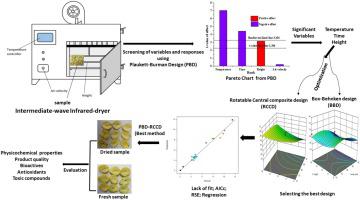Industrial Crops and Products ( IF 5.9 ) Pub Date : 2021-02-01 , DOI: 10.1016/j.indcrop.2021.113287 Isaac Duah Boateng , Xiao-Ming Yang

|
Choosing a suitable intermediate-wave infrared drying condition for dried seeds and selecting the appropriate statistical technique for the drying of seeds to improve bioactive components and desired functionality is paramount in the food industry. In this study, process parameters of the intermediate-wave infrared dryer were optimized for dried Ginkgo biloba L. seeds. The screening by Plackett-Burman design (PBD) indicated that drying time, temperature, and the distance between infrared emitter and samples were the significant factors for green-red (a*), yellowness (b*), ascorbic acid (AA), and rehydration capacity (RC) responses. However, none of the factors was significant for the total flavonoid content responses’. Hence, a*, b*, AA, and RC were used for further optimization. Rotatable central composite design (RCCD) and Box-Behnken design (BBD) optimization were performed to get a minimum AA and a* degradation, maximum b*, and RC. Both designs had acceptable models. Although PBD-BBD had a higher coefficient of determination (R2), PBD-RCCD was selected for further experiment due to a higher lack of fit and lower residual standard error. The optimum conditions using RCCD were temperature =74.6 °C, time =173 min and height = 22 cm. Although dried ginkgo seeds had a lower physicochemical assessment, it had higher product quality, bioactives, antioxidants, and lower toxic components than fresh ginkgo seeds. This provides an opportunity to use an intermediate-wave infrared dryer under these optimum conditions in food processing.
中文翻译:

中波红外干燥的工艺优化:Plackett-Burman筛选;Box-Behnken与中央组合设计与评估的比较:一个案例研究
在食品工业中,为种子干燥选择合适的中波红外干燥条件,并为种子干燥选择合适的统计技术,以改善生物活性成分和所需的功能。在这项研究中,中波红外干燥器的工艺参数针对干燥的银杏叶种子进行了优化。通过Plackett-Burman设计(PBD)进行的筛选表明,干燥时间,温度以及红外发射器与样品之间的距离是绿红色(a *),黄度(b *),抗坏血酸(AA),和补液能力(RC)响应。然而,对于总类黄酮含量的响应,没有一个因素是显着的。因此,a *,b *,AA和RC用于进一步优化。进行了可旋转的中央复合设计(RCCD)和Box-Behnken设计(BBD)优化,以获得最小的AA和a *退化,最大的b *和RC。两种设计都有可接受的模型。尽管PBD-BBD的测定系数较高(R 2),由于缺乏拟合度和较低的残留标准误差,因此选择PBD-RCCD进行进一步的实验。使用RCCD的最佳条件是温度= 74.6°C,时间= 173分钟,高度= 22 cm。尽管干银杏种子的理化评价较低,但与新鲜银杏种子相比,其具有更高的产品质量,生物活性物质,抗氧化剂和较低的毒性成分。这提供了在这些最佳条件下在食品加工中使用中波红外干燥机的机会。


























 京公网安备 11010802027423号
京公网安备 11010802027423号